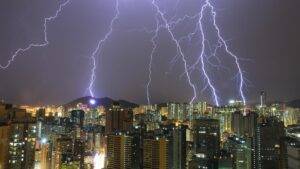A lightning protection system is an essential element of any building or facility to protect it from the damaging effects of lightning events. Testing the efficiency and the continuity of the Lighting Protection system is crucial for attaining the required lightning protection. The lightning protection system must be tested periodically for identifying faults and ensuring proper functioning.
The testing, inspection and maintenance of a lightning protection system are to be based on the IEC 62305-3 Standards. The basic objectives of testing and inspection of a lightning protection system include:
-To confirm that the lightning protection system fits into the requirements mentioned in the standard documents.
-To ensure that all the components of the lightning protection system are in good condition, there is no corrosion and are capable of performing their functions.
-To make sure that any recently added service or construction is properly incorporated into the lightning protection system.
Inspection and Testing Procedure:
The inspection and testing of the lightning protection system comprise the checking of internal and external systems. After a test or inspection is done, the test report or test log is generated and used to record the testing and servicing of the lightning protection system. This must be updated after each inspection, test or service. Inspection must be done at different stages, including:
A) During the Construction or Installation:
The inspection must be done during the construction of the structure and installation of the lightning protection system. This is done to ensure the correct installation procedure, especially for the components that get concealed within the building structure. These components are part of the Structural lightning protection system or the natural components which become part of the lightning protection system.
B) After Installation:
Once all the components of the lightning protection system are installed they need to be inspected and tested. The electrical continuity of such components must be ensured. The complete lightning protection system is checked including the equipotential bonding and the earthing continuity.
C) Periodical Inspection or Testing:
The period of regular inspection can be decided based on the requirements of the structure. It is recommended that inspection or testing must be done at least once a year. The testing inspection or maintenance shall not be conducted during the threat of thunderstorms.
D) After Alterations and Repairs:
Once the structure is struck by lightning the lightning protection system needs to be inspected and repaired. There can be alterations made to the structure such as changes in the use of the building, installations of crane tracks, erection of radio and television aerials etc. So after every alternation or repair of the lightning protection system, the complete system needs to be tested.
Important Parameters:
According to IEC 62305-3, during the periodic inspection and testing of a lightning protection system, the following need to be checked:
a) Deterioration of air termination elements, conductors and connections.
b) Corrosion of earth electrodes.
c) Earthing resistance value for the earth termination system.
d) Conditions of connections, equipotential bonding and fixings.
There are different techniques for testing the lightning protection system. The following are the commonly used methods for testing the reliability of a lightning protection system.
1) Resistance testing
2) Continuity testing
3) Ground or soil resistivity testing
4) Visual inspection
All the mechanical and electrical conditions of all conductors, bonds, joints and earth electrodes should be checked by the above methods. Each of the earthing or grounding points and the conductors connected to them are tested for earth resistance.
Conclusion:
Proper testing of the lightning protection system can ensure that the structure and all its elements are safe from the effects of the lightning strike. The Standard insists that a competent or authorised person should carry out these inspections. A detailed report that includes the findings of the test and recommendations for further protection is obtained after every test. The recommendations provided must be considered, ensuring the required maintenance and upgrades are done. This will ensure the complete protection of the lightning protection system.
Thank you for reading the blog, Axis is a leading manufacturer and supplier of Electrical Components to over 80+ Countries. Talk to our industry expert by visiting our contact us section. You can also watch our videos by our experts – click here.








